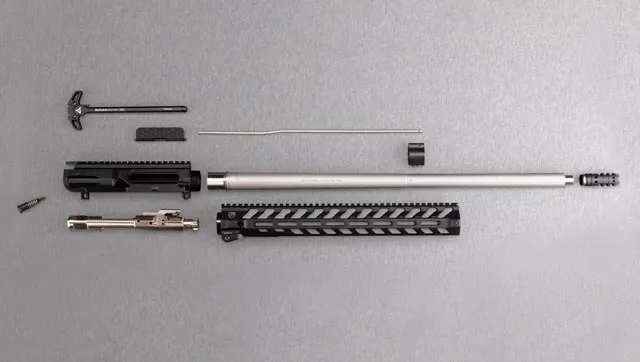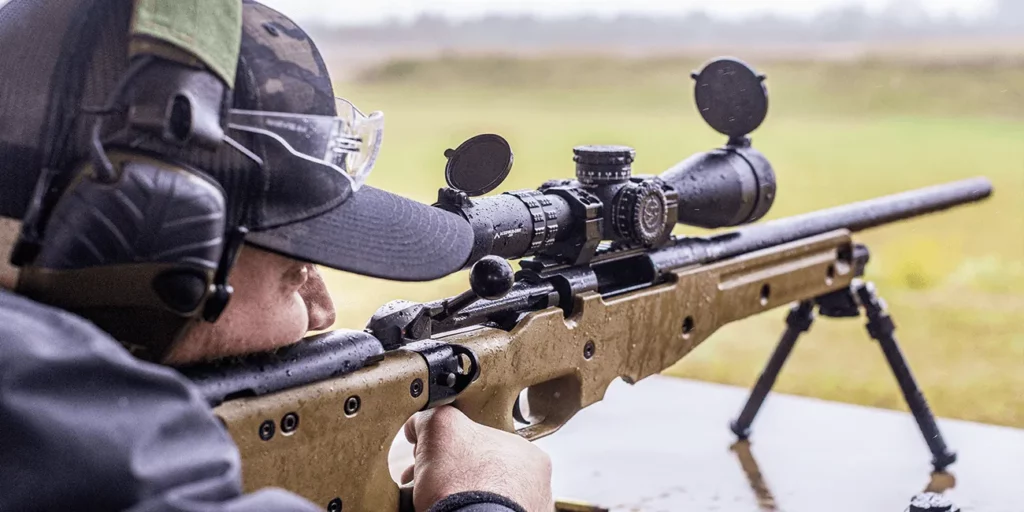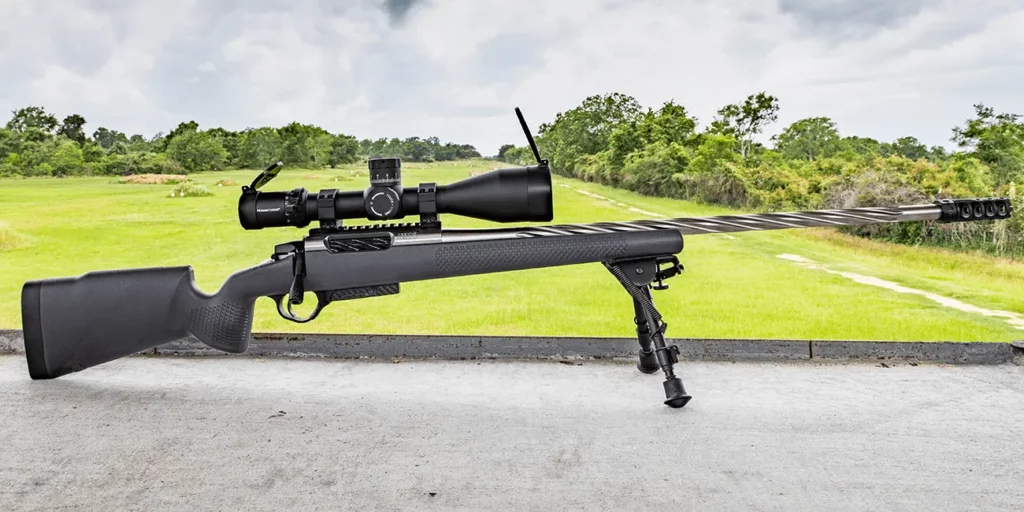It seems like folks have been arguing about caliber for nearly as long as there have been firearms to argue about. Whether it’s 9mm vs .45 ACP, battle rifles vs carbines, or now, 6.5 Creedmoor vs. .308 Winchester, there’s always something new and sleek trying to dethrone what’s old and reliable. But when is it really time to make the switch?

Shop All In Stock .308 Winchester Bolt Action Rifles
.308 Winchester (.308 Win) is arguably the most popular short-action big game hunting caliber in the world. It’s tough to name a rifle caliber more proven on the hunt, in law enforcement use, or for precision competition. .308 Winchester’s balance of power, accuracy, and affordability have made it one of the most popular choices for use in a huge variety of firearms for over 60 years. Thanks to modern bullet and propellant technology, today’s .308 Win is better than ever.
But breakthroughs in technology don’t just make old things better, they drives new innovations too. Competition shooters, always trying to gain an edge, were looking for a way to improve on .308 Win’s best attributes. Enter 6.5 Creedmoor (6.5 CM). This extremely efficient cartridge had to defeat some other worthy contenders to gain its popularity. After long range competitors started flocking to 6.5 CM, hunters took notice as well. Most recently, the US Special Operations Command has turned to the 6.5 CM. In this caliber battle, 6.5 CM is the contender coming out swinging, but can it land a knockout punch to .308 Win? In a AR-10 style rifle, the only difference between these two calibers is the barrel chambering, so which caliber should you choose for your next build?
6.5 Creedmoor vs. .308 Winchester: Let’s battle it out.

Three-Oh-Great
The year is 1952, and the Cold War threatens to get hot at any time. Every weapon system must be improved and optimized — from strategic nuclear weapons to the rifle carried by every American soldier. As the Korean War rages, our servicemen are using the WWII era .30-06 cartridge in their M1 Garand rifles. Ammunition maker Winchester has been working with the military to produce a fully automatic version of the M1 Garand using a detachable 20-round box magazine. Winchester develops the ammunition for this project, using a more efficient boat-tail bullet and new “ball” type gunpowder allowing a shorter casing length. The new caliber is such a winner that they release it to the civilian market first as .308 Winchester. Military adoption as the 7.62×51 NATO cartridge for all NATO countries follows two years later in 1954, and the full auto M1 Garand project became the iconic M14 rifle, adopted by the US Army in 1959.
There are technical differences between the civilian .308 Win and the military 7.62 NATO, but they are so minor that SAAMI, America’s watchdog for ammunition standards, considers them safely interchangeable regardless of which exact version your rifle is chambered for. The military M80 specification loading uses a 147 grain bullet, but current bullet weights for the civilian .308 range from 125 grain bullets all the way up to 200 grain bullets. And that’s just from the factory — you can get even more creative when reloading brass at home by hand.
Six-Point-Five Fever
6.5 Creedmoor was conceived in 2005 when famed long distance record holder Dennis DeMille was challenged by a friend to come up with his requirements for a perfect High Power Rifle Competition caliber. DeMille brought his friend a “wish list” including less recoil than .308 Winchester, relatively good barrel life, and a high efficiency, flat shooting” bullet to promote maximum accuracy at extended ranges. DeMille’s friend was Dave Emary, the senior ballistician at Hornady Manufacturing, Inc. and one of the few people in the world capable of turning DeMille’s wish list into reality. Although it’s easy to assume 6.5 CM grew out of .308 Win, that isn’t true. Emary necked down the forgettable .30 Thompson Center casing to accept a smaller 6.5mm bullet, and named the result after Creedmoor, New York, where legendary long range competitions were held just after the founding of the National Rifle Association in the 1800s. Remember to track down .30 TC brass if you intend on reloading 6.5 Creed.
6.5 CM was officially introduced by Hornady in 2007 as a target shooting caliber suitable for either bolt action or semi-automatic rifles. Long range competition shooters also experimented with several other 6.5mm calibers promising similar performance, including the 6.5×47 Lapua and the excellent .260 Remington. In the years that followed, 6.5 CM first had to prove that it was the best of the new 6.5mm calibers before it could build up enough popularity to challenge .308 Win. Bullets compatible with 6.5 CM measure .264” wide and vary from 120 grains to 155 grains in weight.
Let the battle begin!
The Primary Arms Battle Series takes you through side-by-side comparisons to help you choose which round is best for you. As we compare the two, we have chosen several categories to determine the winner in the 6.5 Creedmoor vs. .308 Winchester showdown.

6.5 Creedmoor vs. .308: Head to Head Ballistics
Both calibers are available in a wide variety of bullet types and velocities. Detailed ballistic data is available from manufacturer’s websites and other sources. For our head to head battle we will compare two of the most efficient loadings for 308 Winchester ballistics and 6.5 Creedmoor ballistics, each fired from a 24” barrel using the latest Hornady Extremely Low Drag (ELD) bullet design.
6.5 Creedmoor shows less bullet drop at all distances. The advantage is minimal at first, at 500 yards the 308 Winchester trajectory is still within 5 inches of the 6.5 CM round. As distance increases, the efficiency of the 6.5mm bullet takes its toll, and by 900 yards it is flying more than three feet higher than the older Winchester bullet, which is just about out of gas. By 1100 yards, .308 Win is already subsonic, while 6.5 CM still has an additional 350 yards (roughly) of effective range.
Bullet drop is relatively easy to account for, remaining fairly consistent for each rifle and loading with only minor changes occurring due to barometric pressure and a few other variables. Where 6.5 CM really shines in long distance shooting is its ability to fight wind, which is much less predictable and more difficult to compensate for. In a 10 mph crosswind, .308 Win has already been pushed six inches farther than 6.5 CM at 500 yards. At 900 yards 6.5CM’s advantage grows to 28.2 inches, about three minutes of angle (MOA) difference.
Winner: 6.5 Creedmoor

Shop All 6.5 Creedmoor Bolt Action Rifles
6.5 Creedmoor vs. .308 Winchester: On The Hunt
On paper, analysis of both calibers reveals numbers sufficient for hunting most big game in North America, but only .308 Winchester can boast an unparalleled 60+ year history of harvesting a huge variety of animals. When Col. Jeff Cooper developed his do-it-all Scout Rifle concept in the early 1980s, he chose .308 Win to make the Scout Rifle “capable of a one-shot kill on any animal weighing up to 1000lbs.” New developments in bullet technology have improved .308 Win greatly in the decades since then. For example, conventional wisdom in the 1960’s and 70’s held that .308 Win didn’t pack enough punch for hunting elk or brown bear. However, using modern bonded or solid hunting bullets, .308 Win is more than capable of felling these great animals, especially under 300 yards.
6.5 Creedmoor trades some bullet weight for increased velocity, resulting in a kinetic energy disadvantage versus 308 Win at ranges under 400 yards. The difference tilts significantly in .308 Win’s favor up close — for hunting under 100 yards, it brings much better potential for a one-shot takedown on large game. After 400 yards the greater efficiency of the 6.5mm bullet allows it to retain energy better than .308 Win, resulting in greater terminal performance. For long distance hunting applications with an intended engagement range beyond 500 yards, 6.5 CM is clearly superior. The limitations of hunting ethics come into play as range increases, as the moral hunter knows to only take shots that will confidently result in a quick and humane kill. Ethics aside, at 700 yards 6.5 Creedmoor still has plenty of steam, carrying over 1100 ft.-lbs. of energy. That’s roughly equivalent to .223 Remington at 100 yards. At the same range, .308 Win lags behind by about 150 ft.-lbs. of energy despite starting out with more bullet weight and more velocity as well.
6.5 CM also recoils significantly less than .308 Win, a factor that really comes into play with light weight hunting rifles in the 6-7lb range. You can cut felt recoil by up to 40% on a .308 Win hunting rifle by attaching a muzzle brake to the end of the barrel. Or, you can accomplish the same recoil reduction by shooting 6.5 CM. Of course, attaching the same muzzle brake to the 6.5 CM would cut its recoil down even more!
Winner: Draw
6.5 Creedmoor vs. .308 Winchester: Going The Distance
.308 Winchester’s legendary accuracy has made it a favorite of military and police snipers worldwide. The amount of time and effort spent by ammunition companies, rifle companies, and individual shooters in refining the .308 Win cartridge to maximize accuracy cannot be calculated. Any police sniper will be expected to place five shots at 100 yards into a group size no larger than one inch, or 1 MOA, with his .308 Win rifle. .308 Win is justly famous as one of the most accurate calibers in the world.
Yet competition shooters are now abandoning .308 Win in large numbers, and running to 6.5 Creedmoor. It’s hard to overstate the accuracy potential of 6.5 CM — after all, it was designed from the start to be the ultimate high power target rifle cartridge. Using relatively affordable, off-the-shelf Ruger Precision Rifles and factory ammunition, 6.5 CM shooters are reporting typical group sizes of 0.8 MOA at 100 yards. Competition shooters with expensive custom rifles and carefully chosen ammunition are showing off best groups in the 0.4 MOA range, less than half an inch at 100 yards. When the bullet diameter itself measures more than a quarter of an inch, it’s easy to see why 6.5 CM shooters aren’t that interested in the old 100-yard accuracy standard anymore. It’s just one ragged hole! They prefer to calculate their accuracy at longer ranges like 200 or 300 yards.
Shop All 6.5 Creedmoor AR Uppers
Accuracy at relatively close range is always good, but 6.5 CM really shows its stuff when the target is far away. Keep going… no, even father than that. The example 147gr 6.5 CM load goes transonic and will lose its accuracy somewhere between 1450 and 1500 yards down range. By comparison the 168gr .308 Win will already be transonic and losing its accuracy between 1050-1100 yards. This is the same bullet design, manufactured by the same company, and the ELD represents a noticeable improvement over previous .308 Win bullet designs — it’s squeezing out the maximum .308 long range shooting potential. Yet it still loses out to 6.5 CM by roughly 350 yards of potential effective range.
Winner: 6.5 Creedmoor

6.5 Creedmoor vs. .308 Winchester: Bang For Your Buck
Ammo costs for both calibers are very close for new production ammo. Expect to pay $0.70 – $0.75 a shot for basic, no-frills loadings, about $1.00 per round for hunting-grade ammunition, and $1.25-1.60 per round for match-grade precision. Military surplus 7.62 NATO ammunition imported from foreign countries like Malaysia and South Korea can still be had for $0.40 – $0.50 per round. You can also get Russian-made .308 Winchester under the Tula and Wolf brands for similar value. This ammo is great for practice at closer ranges or for plinking fun with that historic battle rifle, but you can’t use it for hunting and it will not win any trophies for accuracy either.
There is no cheap Russian or military surplus 6.5 Creedmoor ammo… yet! In March 2018 the US Military Special Operations Command (SOCOM) issued “Request For Proposal” documentation indicating that they intend to replace the .308 Win barrels with new 6.5 CM barrels in Designated Marksman Rifles such as the FN Mk 20 SSR SCAR. This isn’t surprising when you consider that 6.5 Creedmoor significantly increases a sniper’s hit probability at 1,000 meters and lengthens their effective range by about 1/3rd. For us, this means a military specification of 6.5 CM will soon become reality, so it’s possible that “surplus” or at least factory mil-spec 6.5 CM ammo will find its way to the civilian market someday. But for now, that is all pure speculation.
Regardless of cost, .308 Win enjoys a wider variety of available ammunition loadings than any other rifle caliber in existence. After so many decades of development and specialization, there are at least sixteen common bullet weights available for .308 Win, from just 125 grains all the way up to 200 grains, in a stunning variety of full metal jacket, hollow point, soft point, bonded, and polymer-tipped flavors. This makes .308 Win one of the most flexible do-it-all rifle calibers you can buy.
Shop .308 Winchester Ammunition
Winner: .308 Winchester
6.5 Creedmoor vs. .308 Winchester: How Much For That One In The Back?
What do the rifles cost? New bolt-action rifle prices from Ruger, Savage Arms and Remington are generally the same within each model for either caliber. Prices on barrels to build your own AR-308 rifle vary from manufacturer to manufacturer, but making an apples-to-apples comparison between barrels of the same type from the same maker, you’ll find that prices are either identical or so close that the difference isn’t worth mentioning.
.308 Winchester pulls ahead here in terms of general availability in a wide variety of platforms. There are a few designs, especially historic battle rifles, that are available only in .308 Win, but not 6.5 Creedmoor. Right now you would need to do some custom gunsmithing to create an FN FAL or HK G3 type rifle in 6.5 CM, although Springfield Armory did introduce an M1A rifle in 6.5 CM late last year. There are already many thousands of equivalent rifles chambered in .308 Win scattered across the entire globe.
That brings us to the issue of rifles on the used market, and as you might guess with a 60 year head start, it’s a landslide win for .308 Win. Every local gun store, every pawn shop, every gun show is a potential place to score a fair deal on a lightly used Weatherby or Remington 700 just waiting for the right buyer to come along. Used rifles in 6.5 CM are relatively nonexistent—your chances of coming across deep discounts on one in the “Consignment” rack at the local shop aren’t very good at all.
Shop All Ruger American 308 Bolt Actions
Winner: .308 Winchester
6.5 Creedmoor vs. .308 Conclusion
.308 Winchester has an unbeatable pedigree, a giant range of available rifles to choose from both new and used, more affordable plinking ammunition, and even more kinetic energy at the shorter ranges most commonly used for hunting. It’s a proven, incredibly flexible caliber that has earned a place among the all-time great rifle cartridges of the world. If you want the more affordable, more available, more historic option, you can choose .308 Winchester and know you still have excellent accuracy potential, plus a terminally effective range that goes farther than most hunters are willing to take a shot.
6.5 Creedmoor stands on the shoulders of everything we’ve learned about how bullets fly. It represents the cutting edge of ballistic efficiency and is optimized for long range precision. If targets at 600 yards and beyond are your interest, 6.5 CM will get you there with less bullet drop, less wind drift, yet more energy, and your rifle will have less recoil. You won’t really spend any more money on a new rifle or on high quality ammunition to shoot one of the most accurate calibers in the world.
In the debate of 6.5 Creedmoor vs. .308 Winchester, only you can decide which cartridge will fly from your next rifle. Be safe, and shoot straight!



